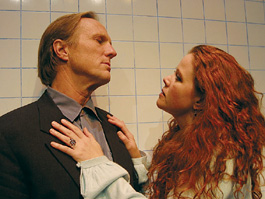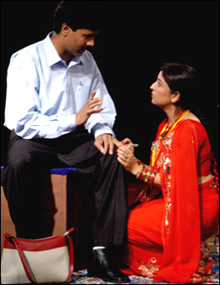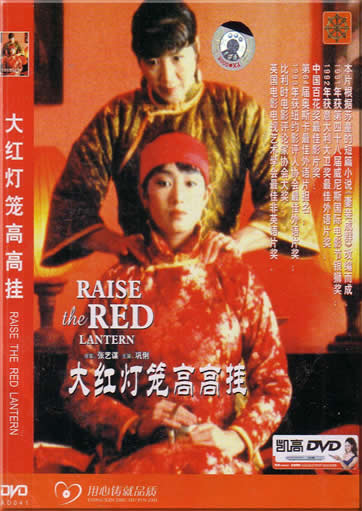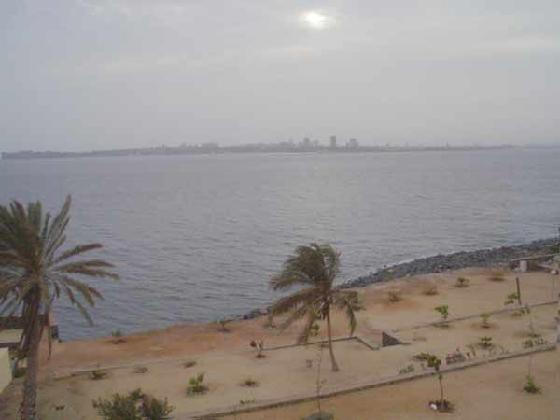 To finish up for now (Thursday), I'd like to add some links to exhibits on African art. When we visit the Freer Gallery in March, if we have time or inclination, we may be able to visit the nearby Museum of African Art. However, while we are reading Heart of Darkness and later on when we are reading Olaudah Equiano's Interesting Narrative and Mariama Ba's So Long a Letter, I'd like for you to be able to look at the links below. By the way, the picture above is of a power figure from the Congo. In fact, the figure dates from the 19th century!! In your opinion, what would Marlow have made of such a figure?
To finish up for now (Thursday), I'd like to add some links to exhibits on African art. When we visit the Freer Gallery in March, if we have time or inclination, we may be able to visit the nearby Museum of African Art. However, while we are reading Heart of Darkness and later on when we are reading Olaudah Equiano's Interesting Narrative and Mariama Ba's So Long a Letter, I'd like for you to be able to look at the links below. By the way, the picture above is of a power figure from the Congo. In fact, the figure dates from the 19th century!! In your opinion, what would Marlow have made of such a figure? (Here I've posted a copy of a British painting from 1912 as contrast. J.W. Waterhouse is not the most avant-garde of artists, but his Penelope and Her Suitors may give you an idea of what people in the early 20th century were used to considering as art and why African art might have been shocking to them.)
(Here I've posted a copy of a British painting from 1912 as contrast. J.W. Waterhouse is not the most avant-garde of artists, but his Penelope and Her Suitors may give you an idea of what people in the early 20th century were used to considering as art and why African art might have been shocking to them.)For more information about the African power figure and its context, see the link below from the Brooklyn Museum:
http://www.brooklynmuseum.org/collections/african_art/22.1421.php
This link takes you to information about that museum's entire collection:
http://www.brooklynmuseum.org/collections/african_art/
Just twenty five years after Heart of Darkness' serialization, the Brooklyn Museum presented an exhibit of African art. At this time, this art was influencing European artists such as Picasso.
http://www.brooklynmuseum.org/research/digital-collections/pna1923/
Closer to home, here are some links to the Smithsonian's Museum of African Art:
http://africa.si.edu/exhibits/africanvision/index2.html
http://africa.si.edu/collections/index.htm
In 1993, the Bayly Museum of Art at the University of Virginia set up an electronic exhibit on African art:
http://www.lib.virginia.edu/clemons/RMC/exhib/93.ray.aa/African.html
NYC has a Museum for African Art. Currently, it is based in Long Island City, but it will soon be moving to a new home in Manhattan.
http://www.africanart.org/index.php
The Guggenheim Museum includes a searchable map of Africa on its web site. Here are links to its pages on Central Africa (the region where the Congo is) and Western Africa (the region where Senegal and Nigeria are).
http://artnetweb.com/guggenheim/africa/central.html
http://artnetweb.com/guggenheim/africa/west.html
The Guggenheim also has a page on African film. Unfortunately, it seems to have been written in the 1990s:
http://www.artnetweb.com/guggenheim/film/
Here is some background information on African art from a web site at Sweet Briar College in Virginia:
http://www.uiowa.edu/~africart/teachers/Chronology.html
http://hum.lss.wisc.edu/hjdrewal/Looking.html
http://hum.lss.wisc.edu/hjdrewal/aesthetics.html
Anne-Marie O'Connor from the LA Times writes here about the ongoing reassessment of African art:
http://www.calendarlive.com/galleriesandmuseums/cl-et-africanart29jan29,0,5808956.story
This is a little off topic, but I thought that you might be interested in this essay on African history from NYC's Metropolitan Museum of Art:
http://www.metmuseum.org/toah/hd/ahis/hd_ahis.htm
I'd like to close with a site from Senegal's DAK'ART Biennale. It is in French. The next exhibition will be this summer, so if you plan to go to Dakar....
http://www.biennaledakar.org/





 It was wonderful to meet everyone and to note how many of you are involved in the arts! I was impressed by how many of you are knowledgeable about film, art, and music. This augurs well for EN 202. Perhaps we will look at more world film than Apocalypse Now and Raise the Red Lantern.
It was wonderful to meet everyone and to note how many of you are involved in the arts! I was impressed by how many of you are knowledgeable about film, art, and music. This augurs well for EN 202. Perhaps we will look at more world film than Apocalypse Now and Raise the Red Lantern.
 It's always interesting (and fun) to look at the covers of different books. Above is a cover of the 2002 edition by Hesperus Press, a British publisher.
It's always interesting (and fun) to look at the covers of different books. Above is a cover of the 2002 edition by Hesperus Press, a British publisher. 





 Since my previous entry on the novel (cross-posted from EN 201) emphasizes the origins of this genre, I'd like to post an entry that emphasizes later works. I will begin with the same definition of the novel that I posted earlier, but we will move in a different direction. In fact, the picture above (the cover of Mariama Ba's novel in French) represents this different direction!
Since my previous entry on the novel (cross-posted from EN 201) emphasizes the origins of this genre, I'd like to post an entry that emphasizes later works. I will begin with the same definition of the novel that I posted earlier, but we will move in a different direction. In fact, the picture above (the cover of Mariama Ba's novel in French) represents this different direction! One genre that we'll be studying in EN 202 and that may seem new to you is life writing. Life writing includes autobiographies, biographies, journals, diaries, memoirs, oral histories, and even letters. Although, at first glance, this genre seems to belong more to history or sociology, reading life history can shed light on the ways that literature shapes how we think and feel as well as influences on literature itself. Some of the earliest novels like Aphra Behn's Oroonoko and Daniel Defoe's Moll Flanders even represent themselves as memoirs or autobiographies. (A memoir covers a part of one's life whereas an autobiography treats the whole of one's life.) And some life writing like Harriet Jacobs' Incidents and Samuel Pepys' Diary is not only fascinating but well-written and worth studying as literature. For example, how does Harriet Jacobs tell her life story in such a way that it appeals to her audience?! How does she depict herself, Dr. Flint, and her grandmother? (Note that although Pepys did not want people to read his diary, both Incidents and the Interesting Narrative were written to be read *and* to change people's minds about slavery.)
One genre that we'll be studying in EN 202 and that may seem new to you is life writing. Life writing includes autobiographies, biographies, journals, diaries, memoirs, oral histories, and even letters. Although, at first glance, this genre seems to belong more to history or sociology, reading life history can shed light on the ways that literature shapes how we think and feel as well as influences on literature itself. Some of the earliest novels like Aphra Behn's Oroonoko and Daniel Defoe's Moll Flanders even represent themselves as memoirs or autobiographies. (A memoir covers a part of one's life whereas an autobiography treats the whole of one's life.) And some life writing like Harriet Jacobs' Incidents and Samuel Pepys' Diary is not only fascinating but well-written and worth studying as literature. For example, how does Harriet Jacobs tell her life story in such a way that it appeals to her audience?! How does she depict herself, Dr. Flint, and her grandmother? (Note that although Pepys did not want people to read his diary, both Incidents and the Interesting Narrative were written to be read *and* to change people's minds about slavery.) The picture above is from a California modern-dress production of A Doll's House. I looked a little bit for a picture from a local production, but I wasn't able to find one quickly. Below is another period production from the University of California at Riverside. The scene depicted is Nora's rehearsal of the tarantella.
The picture above is from a California modern-dress production of A Doll's House. I looked a little bit for a picture from a local production, but I wasn't able to find one quickly. Below is another period production from the University of California at Riverside. The scene depicted is Nora's rehearsal of the tarantella.





















 In 1929, Virginia Woolf maintained, "All women together ought to let flowers fall upon the tomb of Aphra Behn...for it was she who earned them the right to speak their minds" (202). Although Woolf did not have Harriet Jacobs in mind and Jacobs, in turn, did not have Aphra Behn in mind, one of these women might well have been the former slave who wrote Incidents in the Life of a Slave Girl in the 1850s.
In 1929, Virginia Woolf maintained, "All women together ought to let flowers fall upon the tomb of Aphra Behn...for it was she who earned them the right to speak their minds" (202). Although Woolf did not have Harriet Jacobs in mind and Jacobs, in turn, did not have Aphra Behn in mind, one of these women might well have been the former slave who wrote Incidents in the Life of a Slave Girl in the 1850s.  We may read selections from Aphra Behn's Oroonoko alongside the excerpts from Olaudah Equiano's and possibly Harriet Jacobs' slave narratives. Oroonoko, however, was a novel (that may or may not have been autobiographical) written about 100 years before Equiano's time and over 150 years before Jacobs'. Some scholars argue that Oroonoko even predates the novel. Others argue that the protagonist's royal blood was much more important to the author than his race was and that she was using this story to comment on the then-current political situation in England. (In November of the year that Oroonoko was published, James II fled from England and was deposed. The new king was his Protestant son-in-law, William of Orange.)
We may read selections from Aphra Behn's Oroonoko alongside the excerpts from Olaudah Equiano's and possibly Harriet Jacobs' slave narratives. Oroonoko, however, was a novel (that may or may not have been autobiographical) written about 100 years before Equiano's time and over 150 years before Jacobs'. Some scholars argue that Oroonoko even predates the novel. Others argue that the protagonist's royal blood was much more important to the author than his race was and that she was using this story to comment on the then-current political situation in England. (In November of the year that Oroonoko was published, James II fled from England and was deposed. The new king was his Protestant son-in-law, William of Orange.)
